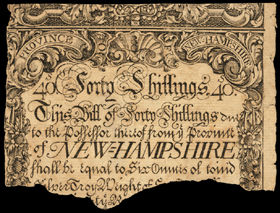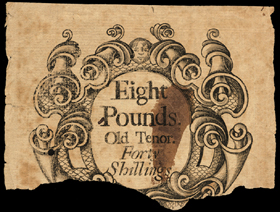New Hampshire Currency
April 3, 1742 (plates reused through July 12, 1746)
An emission of £4,720 in New Tenor legal tender bills of credit was authorized on April 3, 1742. The was the first New Hampshire issue of new tenor notes, which were valued at 6s8d per troy ounce of sterling silver (which was equal to 5s2d in British silver coinage). This was equal to four times the value of old tenor notes, therefore on the back of each note was the denomination in both old and new tenor; for example, 40s or £2 new tenor was equal to £8 in old tenor bills. An additional quantity of £1,280 in notes were printed with this press run but were held in reserve until being issued under an act of September 28, 1743.The two plates for this emission were engraved in Boston by Thomas Johnston, who also printed the notes. The plates were then used for an emission authorized on April 3, 1742 for mortgage loans with the notes valued at 8s per troy ounce of sterling silver (but without changing the rate on the plates). This emission was approved by the Lords of Trade and Plantations in Britain on June 2, 1743 therefore the date 1743 was added to the plates just above the signature area, usually to the right of the center just below the frame around the text, also the letter L was added to each engraving. The plates were then used for the February 1744/45 emission with the date of February 1744 added to the obverse of each note, somewhere below the central text, usually just below the central frame, toward the left margin. Additonal quantities of notes were printed without any further redating of the plates for the follwoing three issues: an emission of £6,000 by an act of July 6, 1745; an emission of £8,000 by an act of October 5, 1745 and finally a large emission of £60,000 was authorized to finance an expedition into Canada by an act of July 12, 1746. During this period the value of sterling silver continued to rise so that by 1745 it was 8s9d per troy ounce. Notes from the February 1744/45 through the July 12, 1746 emissions cannot be distinguished. The dating 1744/45 refers to the situation that at that time the British celebrated the New Year in March so the date on the notes "February 1744" is converted to February 1745 using our current calendar. The plates survive in the New Hampshire Division of Archives and Records in Concord, NH. Denominations for the April 3, 1742 issue include: 6d, 1s, 2s6d, 6s, 7s6ds, 10s, 20s and 40s.
obv
 rev
rev
40s (counterfeit) Fragment, top one third of the note Serial Number: missing NH 04/03/42
Signers: missing.
Size: fragment 103 x 78mm.
Comments: This is a torn fragment of the top one-third of a note. The portion that remains is in very fine condition, indeed the front shows much of the top border, which is a section completley missing from the example plated by Newman (4th edition, p. 229 and 5th edition, p. 233). The Notre Dame fragment has been attributed to the original April 3, 1742 emission as there is no letter L on the note. The Newman plate of the 1743 redated variety has an L above the word Shillings at the top, the L is found on all denominates of reuses of the plate. Except for this added letter the specific emission of this note cannot be confirmed because the portion with the dating (and redating) is lost. With the exception of the added L the text visible on this fragment was the same as was printed on all emissions from April 3, 1742 to July 12, 1746. On the front the frame around the central text consists of acanthus leaves and flowers. From more complete examples the full text can be reconstructed: "PROVINCE OF NEW=HAMPSHIRE / 40.s Forty Shillings 40.s / This Bill of Forty Shillings due / to the Possessor thereof from ye province / of NEW=HAMPSHIRE shall be equal to Six Ounces of coin'd / Silver Troy Weight of Sterling Alloy, or / Gold Coin at ye Rate of Four Pounds / Eighteen Shillings pr Ounce, and shall be / so accepted in all payments and in the / TREASURY. PORTSMOUTH Apr. 3d 1742 / By Order of ye GENERAL / COURT or ASSEMBLY." Note that the O and F in the top line ate seperated on either side of the shell. The back of this example has much of the cartouche remaining. The face at the top is more distinct that in the Newman plate. Within this frame is the the old and new tenor equivalency but with a large ink stain, the text reads "Eight / Pounds. / Old Tenor. / Forty / Shillings" [that is, 40s New Tenor].
On February 6, 2012, David Sundman of the Littleton Coin Company explained to me in an e-mail that the Notre Dame note is a contemporary counterfeit. It is very close to the original and thus is quite deceptive, but through careful analysis David has been able to uncover this previously unknown forgery. Using a modern reprint made from the original plate held in the New Hampshire Division of Archives and Records (in Concord, NH), and a left-half fragment of an original 40s note in his private collection, David determined that several of the letters on the front of the Notre Dame specimen varied from the norm. For example, the "of" in "of NEW=HAMPSHIRE" differs significantly, in the original the "of" has a very short cross stroke on the f, while the Notre Dame example displays a cross stroke that extends back to and touches the o. Several other points of difference can be seen. Here is David's marked version of the Notre Dame note showing some of the differences and here is an image of a modern reprint produce from the plate held in the New Hampshire Archives for comparison.
Provenance: Purchased through the Robert H. Gore, Jr. Numismatic Endowment from the R.M. Smythe Sixth Annual Chicago Paper Money Exposition 2/17-18/2000, Auction 196, lot 1018.
Note of February 6, 2012: Thanks to David Sundman for contributing information on this note.